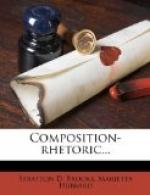—Hawthorne: The House of the Seven Gables.
3. One of the best known of the flycatchers all over the country is the kingbird. He is a little smaller than a robin, and all in brownish black, with white breast. He has also white tips to his tail feathers, which look very fine when he spreads it out wide in flying. Among the head feathers of the kingbird is a small spot of orange color. This is called in the books a “concealed patch,” because it is seldom seen, it is so hidden by the dark feathers.
—Mary Rogers Miller: The Brook
Book.
(Copyright, 1902, by Doubleday, Page and Co.)
Notice the use of a comparison in establishing a correct fundamental image in example 3.
B. Select five buildings with which the members of the class are familiar. Write a single sentence for each, giving the fundamental image. Read these sentences to the class. Let them determine for which building each is written.
C. Notice the pictures on page 218. Write a single sentence for each, giving the fundamental image.
+Theme LII.+—Write a paragraph, describing something with which you are familiar.
Suggested subjects:—
1. The county court house.
2. The new church.
3. My neighbor’s
house.
4. Where we go fishing.
5. A neighboring lake.
6. A cozy nook.
(Underscore the sentence that gives the fundamental image. Will the reader get from it at once a correct general outline of the object to be described? Will he need to change the fundamental image as your description proceeds?)
+121. Point of View.+—What we shall see first depends upon the point of view. Seen from one position, an object or a landscape will present a different appearance from that which it will present when viewed from another position. A careful writer will give that fundamental image that would come from actual observation if the reader were looking at the scene described from the point of view chosen by the writer. He will not include details that cannot be seen from that position even though he knows that they exist.
Notice that the following descriptions include only that which can be seen from the place indicated in the italicized phrases:—
Forward from the bridge he beheld a landscape of wide valleys and irregular heights, with groves and lakes and fanciful houses linked together by white paths and shining streams. The valleys were spread below, that the river might be poured upon them for refreshment in day of drought, and they were as green carpets figured with beds and fields of flowers and flecked with flocks of sheep white as balls of snow; and the voices of shepherds following the flocks were heard afar. As if to tell him of the pious inscription of all he beheld, the altars out under the open sky seemed countless, each with a white-gowned figure attending it, while processions in white went slowly hither and thither between them; and the smoke of the altars half risen hung collected in pale clouds over the devoted places.




